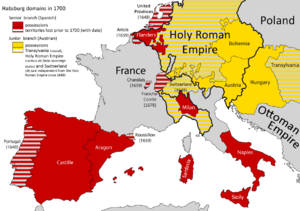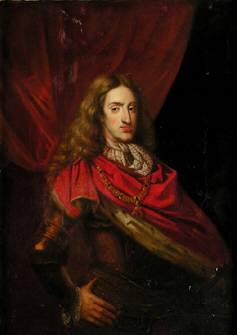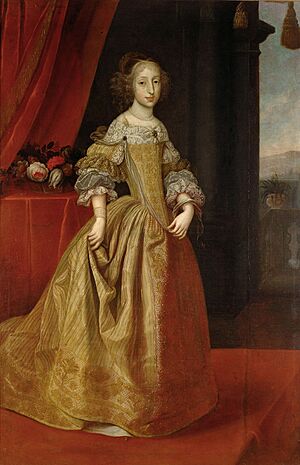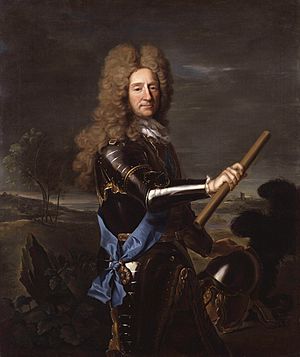Treaty of The Hague (1698) facts for kids
| First Treaty of Partition between Great Britain, France and the United Provinces | |
|---|---|

Habsburg possessions in Spain (red), and Austria (yellow)
|
|
| Context | Concerns over the inheritance of Charles II of Spain |
| Signed | 11 October 1698 |
| Location | The Hague |
| Negotiators |
|
| Signatories |
|
| Parties | |
The 1698 Treaty of The Hague was an agreement between France, Great Britain, and the Dutch Republic. It was also called the First Partition Treaty. This treaty was an attempt to solve a big problem without starting another war. The problem was who would inherit the Spanish Empire after the King of Spain died.
King Charles II of Spain was very sick and had no children. His death was expected soon. The closest relatives who could inherit his throne were from two powerful families: the Austrian Habsburg monarchy and the French House of Bourbon. If either family took over the entire Spanish Empire, it would make them too powerful. This would upset the "balance of power" in Europe, meaning no one country would be much stronger than others.
The treaty was signed on October 11, 1698. It decided that a six-year-old boy named Joseph Ferdinand of Bavaria would become the King of Spain. Spain's lands in Europe would be split between France and Austria. However, Spain and Austria were not part of these talks. They did not agree with the plan to divide the Spanish Empire.
Sadly, Joseph Ferdinand died in February 1699. This meant a new plan was needed. So, a second agreement, the Treaty of London, was made in March 1700.
Contents
Why the Treaty Was Needed: The Spanish Succession
In 1665, Charles II became the last king from the Habsburg family to rule Spain. He was often sick throughout his life. By 1697, it seemed very likely he would die without any children.
Even though Spain's power had lessened, the Spanish Empire was still huge. It included lands in Italy, the Spanish Netherlands (parts of modern-day Belgium and the Netherlands), the Philippines, and large areas in the Americas.
Since Charles II had no direct heirs, the question of who would rule this vast empire was very important. His closest relatives were from the powerful Austrian Habsburg and French Bourbon families. Many European countries worried that if one family gained all of Spain's lands, it would make them too strong. This could lead to a major war.
France's King Louis XIV had fought several wars to make France stronger. The most recent was the Nine Years' War (1688–1697). This war was against a group of countries called the Grand Alliance. The war ended with the Treaty of Ryswick in 1697. France gained only a little from it. Louis XIV realized he needed allies to achieve his goals.
Austria had also become stronger. They had won battles against the Ottoman Empire and taken over lands like Hungary. This made the Austrian Emperor, Leopold I, more confident. He initially didn't want to sign the Treaty of Ryswick because it didn't solve the Spanish succession problem. Many people thought the treaty was just a short break before more fighting.
How the Treaty Was Negotiated
The Spanish throne could be passed down through female family members. This meant Charles II's sisters could pass their right to their children. Both of his sisters had one child who was still alive.
His half-sister, Maria Theresa, married King Louis XIV of France. Their son was Louis, the Grand Dauphin. Charles's full sister, Margaret Theresa, married Emperor Leopold I of Austria. Their daughter, Maria Antonia, married Maximillian Emanuel. They had one son, Joseph Ferdinand.
In Spain, there were two main groups of politicians. One group supported the Austrian family, and the other supported the French family. When Charles II became very ill in 1698, Louis XIV of France found it helpful to work with Great Britain.
William III was a very important leader in Europe. He was both the King of England and the leader (Stadtholder) of the Dutch Republic. He had led the Grand Alliance during the Nine Years' War. A war over the Spanish throne would affect the safety of both England and the Dutch Republic.
England's army was very small by 1699. This made a peaceful solution attractive to William. It was a chance to create a lasting peace. Talks to end the Nine Years' War had started in 1694. But they only finished in 1697 after Louis XIV and William III talked directly. Because of this, they believed they could prevent another war over the Spanish succession. However, Austria and Spain, the countries most affected, were not included in these talks.
The first discussions were held in Paris. The Earl of Portland from England and the Marquis de Pomponne from France talked there. More important talks began in May at The Hague. Anthonie Heinsius, a key Dutch official, and the French foreign minister, the duc de Tallard, joined these talks.
Finally, on October 11, 1698, the treaty was signed. Tallard signed for France, Portland for England, and eight representatives signed for the Dutch Provinces.
What the Treaty Decided
King Louis XIV first suggested his son, the Grand Dauphin, as Charles II's heir. But this idea was rejected by the others. So, they agreed on Joseph Ferdinand of Bavaria. This choice was supported by Charles II's German wife, Maria Anna. Joseph Ferdinand's father was Max Emmanuel of Bavaria.
The treaty said that Joseph Ferdinand would inherit most of the Spanish Empire. This included the Spanish Netherlands, which Max Emmanuel already governed. France would receive the Kingdoms of Naples and Sicily in Italy. They would also get the modern Basque province of Gipuzkoa in Spain.
Finally, Emperor Leopold I's younger son, Archduke Charles, would become the ruler of the Duchy of Milan. This land was important for Austria's southern border safety.
The negotiations were kept secret. This was normal for Louis XIV's government. But in England, the senior legal officer, Lord Chancellor Somers, found out about the treaty just before it was signed. He didn't like the terms. But since it was already agreed, he felt he couldn't change it.
What Happened After the Treaty
The Spanish people did not want their empire divided without their input. So, on November 14, 1698, King Charles II made his own will. He named Joseph Ferdinand as the heir to an independent and undivided Spanish Empire. Maria Anna was named Queen Regent to rule until Joseph Ferdinand was old enough.
In February 1699, Joseph Ferdinand died from smallpox. This was a common disease back then. His death was a big surprise. It's unclear if he would have become king even if he had lived, as many people didn't like the treaty. Some think Louis XIV saw the treaty as a way to gain time. He might have wanted to build support for a French candidate in Spain.
Because Joseph Ferdinand died, the three countries involved had to start new talks. This led to the Second Partition Treaty, also known as the Treaty of London.
Images for kids
See also
 In Spanish: Primer Tratado de Partición para niños
In Spanish: Primer Tratado de Partición para niños










